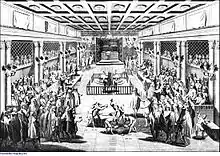_-_P.M._YITZHAK_SHAMIR_WAVING_A_NOISEMAKER.jpg.webp)

.jpg.webp)
A grager (Yiddish: גראַגער, 'rattler'), also gragger, grogger or gregger,[1] is a noisemaking device, most commonly a ratchet, used to make noise by the congregation when the name of Haman is read out during the recitation of the Megillah in the synagogue during the celebration of Purim in order to blot out Haman's name. This is done in accordance with the passage in the Midrash which commented that the verse from Deuteronomy "Thou shalt blot out the remembrance of Amalek"[2] must be understood "even from wood and stones". Traditionally Haman is believed to be an offspring of Amalek, and a tradition had developed to write the name of Haman on stones and to knock them until the name is blotted out.[3][4]
Etymology
Eliezer Ben-Yehuda initially suggested the word Hebrew: מנענע, 'shaker', for the Purim noisemaker, but under the influence of Yiddish the term Hebrew: רעשן ra'ashan for rattler (from the Hebrew ra-ash, meaning 'noise', suggested by Ben Yehuda's son, Itamar Ben-Avi)[5][6] was accepted.[7]
Origins and controversies
The custom can be traced back to the Tosafists of the 13th century,[8] and the leading Sephardic and Ashkenazi halachic authorities, Rabbi Yosef Karo, and Rabbi Moshe Isserles stated "one should not nullify the custom or belittle it", as the custom bears meaning and significance.[9] Some later rabbis of the 19th century, including Sefardi chief rabbis of Jerusalem, Raphael Meir Panigel, and of Izmir, Haim Palachi, protested against the noisemaking tradition, considering it an improper disturbance obstructing the reciting of the Megillah.[10]
Manner of noisemaking
While the blotting out was originally done by clapping two stones or pieces of wood on which "Haman" had been written or drawn, today the noisemaking of "blotting out" is the common practice. Many Kabbalists and Chassidim would stamp their heels, which represent Amalek, the ancestor of Haman.[9] Some have the custom to only make noise when Haman is mentioned with a title or adjective.[11]
Rabbi Shimon Apisdorf suggests that any noisemaker will do: "alarm clocks, toddler xylophones, dolls that cry with the push of a button, a toy police car with siren and flashing lights or anything else that will make a wonderfully annoying noise".[4]
Gallery
See also
- Yimakh shemo ("May his name be erased")
- Crotalus, a similar object used by Catholics during the Paschal Triduum
References
- ↑ "Definition of GRAGER". Merriam-Webster. Retrieved 2022-07-10.
- ↑ "Deuteronomy 25 / Hebrew - English Bible / Mechon-Mamre". mechon-mamre.org. Retrieved 2023-10-16.
- ↑ Kaplan, Sybil (2020-03-06). "Why groggers on Purim?". Jewish Independent. Retrieved 2022-07-10.
- 1 2 An excerpt related to groger from: Apisdorf, Shimon (1998). The One Hour Purim Primer: Everything a Family Needs to Understand, Celebrate and Enjoy Purim. Leviathan Press. OCLC 44122322.
- ↑ Itamar Ben-Avi, החצוף הארצישראלי, available online. Quote: "למפה קטנה קראתי “מפּית”, לעגלת־עבודה קראתי “עגלילה”, ומן הפועל רעש יצרתי “רעשן” של פורים, ומנחש עשיתי “נחשן” למעופף עשוי־נייר. "
- ↑ "איתמר בן אב"י, לימודי ירושלים, סיורים וקורסים בירושלים" (in Hebrew). Retrieved 2022-07-10.
- ↑ Gilad, Elon (2021-02-26). "בן יהודה רצה שהרעשן ייקרא מנענע, אך דוברי היידיש דיברו בקול רם". Haaretz (in Hebrew). Retrieved 2022-07-10.
Ben Yehuda wanted the rattle to be called shaker, but Yiddish speakers spoke out
- ↑ Algemeiner, The (2013-02-24). "Blotting Out Haman's Name While Listening to the Reading of the Megillah (PHOTO BLOG) - Algemeiner.com". www.algemeiner.com. Retrieved 2023-03-03.
- 1 2 Shurpin, Yehuda. "The Origins of the Gragger: Why We Boo Haman". chabad.org. Retrieved 3 March 2023.
- ↑ "Comunicado sobre la actitud en los festejos de Purim". Rabino Isaac Sacca (in Spanish). 2018-02-22. Retrieved 2022-07-10.
- ↑ Silberberg, Naftali. "Megillah Laws and Customs". Retrieved 3 March 2023.
_(8467835716).jpg.webp)
_(8466740399).jpg.webp)
_(8467836426).jpg.webp)
